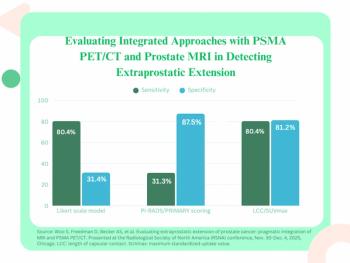
Report from SIR: Terminal cancer patients find pain relief in ablation
Percutaneous thermal ablation, alone or combined with radiation therapy, can reduce the excruciating pain caused by chest wall tumors, according to a study by Brown University researchers.
Percutaneous thermal ablation, alone or combined with radiation therapy, can reduce the excruciating pain caused by chest wall tumors, according to a study by Brown University researchers.
Patient achieved considerable pain reduction after successful RFA of NSCLC that had spread into the thoracic spine. (Provided by D. Dupuy)
The study, reported at the 2006 Society of Interventional Radiology meeting in Toronto, found the palliative strategy improved the quality of life in these patients. It also found a statistically significant improvement in survival.
Radiofrequency, microwave, and cryoablation allow interventional radiologists to reduce patients' chronic pain in a minimally invasive way, enabling them to enjoy whatever time they have left without serious side effects, said coauthor Dr. Damian E. Dupuy, an interventional radiologist at Brown's Medical School.
More than 80% of advanced lung, breast, and prostate cancers produce skeletal metastases. While the primary tumor may not be painful, the associated bony lesions can cause severe, disabling pain. About 50% to 70% of patients with primary tumors affecting the thoracic wall suffer uncontrollable pain that makes even breathing unbearable.
Until now, physicians have treated these patients with heavy doses of narcotics, which may not provide adequate pain relief and radically diminish their quality of life.
Dupuy and colleagues enrolled 52 patients with a median age of 65 years. They performed palliative procedures on 58 thoracic tumors (51 RFA, five MWA, two cryo procedures). Seventy-five percent of patients also underwent external-beam radiation therapy.
The researchers reviewed thermoablation results within one or two weeks after treatment and followed up patients for more than a year. The most common type of metastatic skeletal lesions derived from non-small cell lung and breast carcinomas affecting the rib cage (n = 35) and thoracic spine (n = 9).
The investigators documented pain outcomes from 39 patients, with a median follow-up of six months. Almost 72% of these patients reported reduced pain, with 93%, 60%, 40%, and 20% of them reporting that positive effects from therapy lasted 30, 90, 180, and 365+ days, respectively.
Researchers could not establish a cause-and-effect relationship between pain reduction and survival, but they found a statistically significant increase (p = 0.001) in the survival rate of patients reporting the most benefit from ablative therapy. They added the observation, which was not an end point of the study originally, and recommended further review of the improved survival/pain relief association, Dupuy said.
"The study findings suggest a synergistic interaction between palliative thermoablation when temporarily combined with radiation therapy. Overall, percutaneous thermoablation appears to be a safe, efficacious, and durable alternative for the treatment of painful chest wall masses," he said.
Newsletter
Stay at the forefront of radiology with the Diagnostic Imaging newsletter, delivering the latest news, clinical insights, and imaging advancements for today’s radiologists.



























